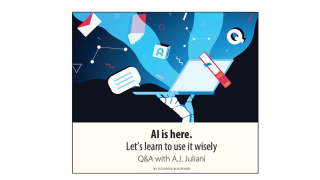When implementing a new initiative to help teachers, what really makes a new technology or resource stick?
Learning Forward’s recent report, Beyond Barriers: Encouraging Teacher Use of Feedback Resources, looks at the value of investing in change management processes to aid in the adoption and use of new tools. We often talk about change management, but how much do we really do?
The report refers to specific change management strategies, including:
- Increasing awareness about available products and services and the potential benefits and rationale for their use;
- Engaging users in decision-making about the products and services;
- Identifying and addressing implementation challenges quickly and effectively; and
- Evaluating the efficiency, effectiveness, and impact of the products and services.
The study suggests that effective change management has a significant effect on the scaling and spread of an innovation.
When managing change, awareness is a crucial first step: What do people actually know? Do they recognize the initiative as a viable approach to solving a problem? Do they even recognize the problem?
Without a solid base of awareness and understanding, getting buy-in and use of a new innovation is unlikely to succeed. Building awareness takes time and dedicated effort, and educators can overestimate the amount of knowledge across systems.
Addressing the following questions along the way will help identify and manage key factors in fostering adoption and use of a new innovation.
- Can we enroll our peers as advocates along the way and allow them to communicate as agents of change?
- Can we enroll both advocates and naysayers in the decision-making process?
- Can we learn why people with negative outlooks on the process are positioned that way?
- Are their positions entrenched and based on reason, or will they become more flexible when they learn more about the initiative?
Once the new initiative is under way, it’s best to be honest about progress and transparent about both the benefits and drawbacks of the new implementation. Some points to consider: What were our goals at the outset? Were we clear about these? What has gone well and what hasn’t? What can we change along the way? Do we have enough information quickly enough to make midcourse corrections? How might we get that?
Two case studies included in the Beyond Barriers paper highlight a slightly different approach to successful change management. There is no one right approach to these challenges, but asking the right questions along the way can help immeasurably with planning.
Learning Forward’s Standards for Professional Learning address change management through the Implementation standard, which stresses the importance of both applying change research and sustaining support if long-term change is the goal.
Several Learning Forward resources address aspects of change management and introducing a new initiative, including these facilitator modules on change management as well as several books that show how addressing change is critical to implementing new initiatives, such as Becoming a Learning System and Becoming a Learning Team.
We invite you to dig into the report and consider how the findings might help you in your context. We are also interested in hearing about your implementation strategies and successes.
This study was supported by the Bill & Melinda Gates Foundation.





![Poil blog v1[1]](https://learningforward.org/wp-content/uploads/bb-plugin/cache/poil-blog-v11-custom_crop.jpg)



